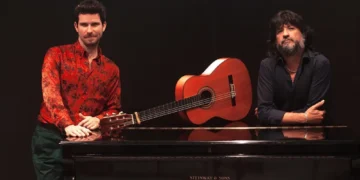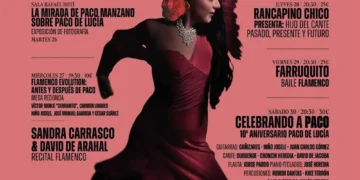|
|
|
Text: Estela Zatania Maghreb Flamenco Juan Gómez ‘Chicuelo’ Quartet Saturday, the Dutch flamenco bienal was full of activities in the three cities that are hosting the program of activities, conferences and courses. In Amsterdam, the day began with a children’s show, “El Flamenco en Cuatro Estaciones”, with the company of Silvia Marín, and in the evening, guitarist Josele was featured in what was billed as “a musical encounter between two cultures”. One of the main objectives of the festival is to show the various cultural paths and music that influenced the development of flamenco as we know it today.
“Quién tiene moro tiene oro”, which more or less means ‘Moors are worth their weight in gold’, is an old saying that dates from centuries back when gypsies, Africans and Jews worked and lived together in the fields of Andalusia. In the heart of the bread-basket, these marginal groups needed no papers and worked for low wages, which is the origin of the saying. In this setting, the musical interchange was inevitable, and in fact, the most identifying characteristic of the aesthetic of flamenco, is its orientalism filtered through European traditions and artistic sense. Without worrying much about historical accuracy or flamencology, the festival organization placed the guitarist from Almería, Juan José Heredia, known to flamenco fans as “Niño Josele”, in a joint recital with Berber singer Cherifa Kersit from the Atlas mountains of Morocco. The recital was divided in three parts: guitar and cante with Niño Josele’s group – taranta, alegrías, bulerías – traditional music of the Moroccans, and then the joining of both in a more or less coherent way. The highlights of the recital were Josele’s guitar and the voice of the North African singer that sliced the air into razor-thin portions that cut with brutal precision. Both groups were much appreciated, and it occurs to me that for the Dutch audience, flamenco is as exotic as Moroccan music. What both genres mostly have in common is certain parallel scales, and the tendency to frenetic build-ups in the long endings. It was also a good opportunity to compare the folkloric harmony-free Berber music, and the sophisticated stylized offering of flamenco, as well as its greater rhythmic complexity. Immediately following, and three floors up in the café cantante, another guitarist, Juan Gómez “Chicuelo”. From the same generation as Niño Josele, the one touched by the genius of Paco de Lucía, Chicuelo, from Catalonia, has a more traditional approach, less jazz-influenced than Josele’s, and a very flamenco touch. He played taranta alone (these days guitar “solos” can be in group or alone, funny), alegrías, tangos and bulerías with the cante of Joaquín Gómez “El Duende”, the viola of Elizabeth Gex and a percussionist.
|
Descubre más desde Revista DeFlamenco.com
Suscríbete y recibe las últimas entradas en tu correo electrónico.




























